Level Up Your Social Media Game
Creating engaging social media content and sticking to a consistent schedule is challenging. Stop struggling and start succeeding with a social media content planning template. To make these tools truly effective, they should be part of a broader social media marketing plan that defines goals, platforms, and success metrics before content is scheduled.
This list of 7 powerful tools will transform your social media strategy. Discover templates from industry leaders like Hootsuite, Buffer, and Sprout Social, plus adaptable options like Trello and Notion, to simplify your planning, improve organization, and boost your social media presence. Find the perfect social media content planning template to streamline your workflow and achieve your content goals.
1. Hootsuite’s Social Media Content Calendar
When it comes to streamlining your social media presence, a robust social media content planning template is essential. Hootsuite’s Social Media Content Calendar stands out as a powerful tool designed to help businesses and marketers plan, organize, and schedule content across various platforms. This comprehensive template provides pre-built sections for content planning, campaign tracking, and performance metrics, making it a one-stop shop for all your social media content needs. Its seamless integration with Hootsuite’s broader social media management platform further enhances its value, offering both free and premium versions with advanced features to cater to diverse needs. Whether you’re managing a complex campaign or simply need to organize your weekly posts, Hootsuite offers a solution to level up your social media game.
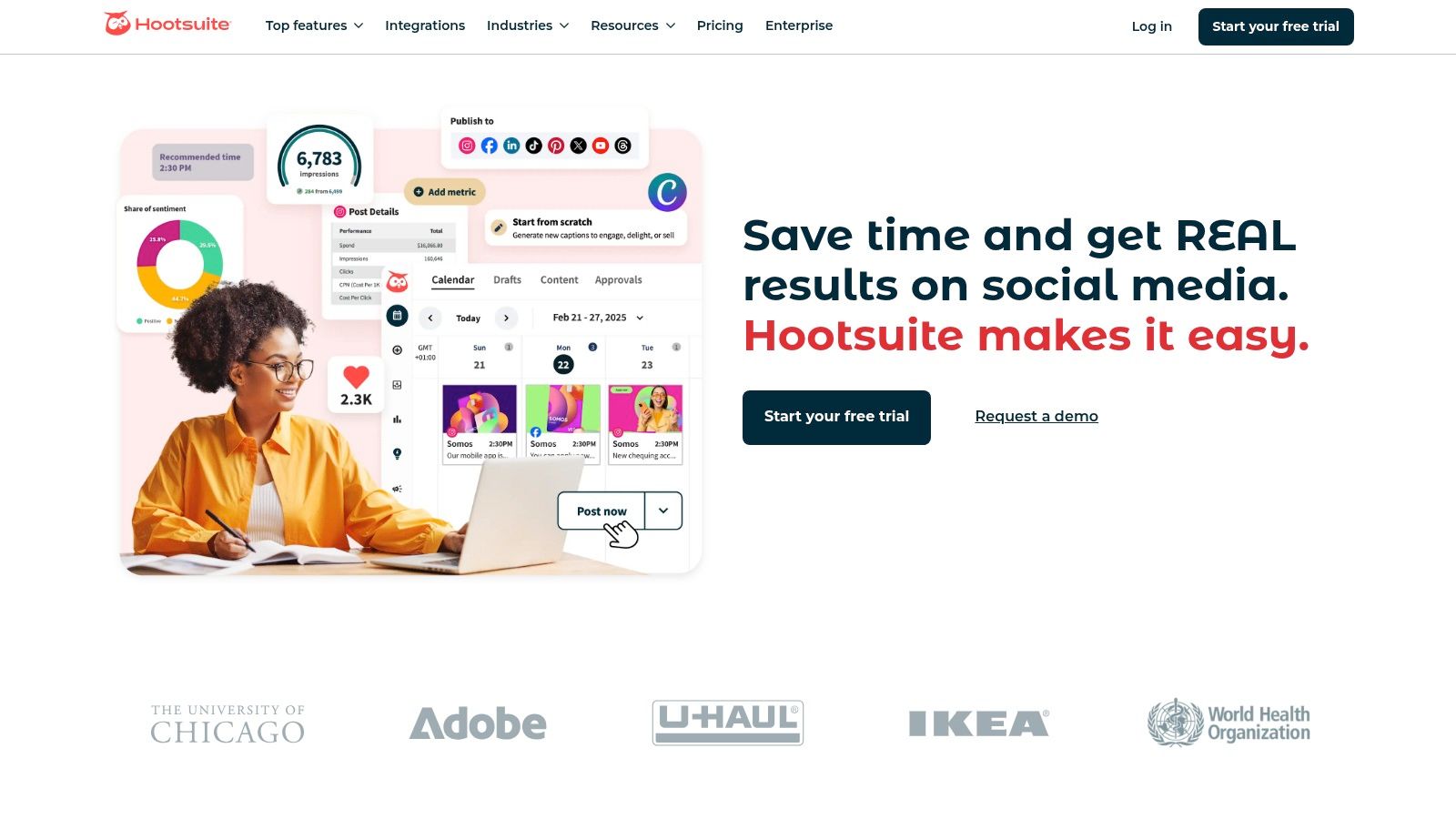
Hootsuite’s template excels in its ability to facilitate multi-platform content planning. You can manage content for Facebook, Instagram, Twitter, LinkedIn, Pinterest, and YouTube all within a single interface. This eliminates the need to juggle multiple spreadsheets or applications, simplifying your workflow significantly. The built-in content categorization system, utilizing tags and labels, allows you to easily organize and filter content based on topics, campaigns, or any other criteria relevant to your strategy. This granular control ensures you maintain a consistent brand voice and messaging across all platforms.
For those running specific social media campaigns, Hootsuite’s calendar offers dedicated campaign tracking and hashtag management tools. You can monitor the performance of individual campaigns, track hashtag usage, and analyze the effectiveness of your social media efforts. This data-driven approach empowers you to optimize future campaigns and refine your social media content planning template to achieve better results. The template also facilitates team collaboration with built-in approval workflows. Team members can contribute to the content calendar, suggest edits, and obtain approvals before publishing, ensuring consistent brand messaging and minimizing the risk of errors.
One of the major advantages of using Hootsuite’s social media content planning template is its tight integration with Hootsuite’s ecosystem of tools. This seamless integration allows you to directly schedule and publish content from the calendar to your connected social media accounts. You can also access Hootsuite’s analytics tools to track the performance of your content and gain valuable insights into audience engagement. While Hootsuite offers a free version of its platform, some advanced features within the content calendar, such as unlimited scheduling and advanced analytics, require a paid subscription. Pricing varies depending on the chosen plan, with options catering to individuals, small businesses, and large enterprises. Technical requirements are minimal, primarily requiring a stable internet connection and a web browser.
For small businesses or solo creators with simpler content planning needs, the template’s extensive features might feel overwhelming. Alternatives like Trello or even a basic spreadsheet might suffice in such cases. However, for businesses managing multiple social media accounts and campaigns, the benefits of a centralized platform with integrated scheduling and analytics like Hootsuite far outweigh the learning curve.
To implement Hootsuite’s Social Media Content Calendar, start by signing up for a Hootsuite account (free or paid). Once logged in, explore the templates section and select the social media content calendar. Connect your social media accounts and start populating the calendar with your planned content. Experiment with the tagging and labeling system to organize your content effectively. Explore the collaboration features and establish approval workflows if working with a team. Finally, utilize the integration with Hootsuite’s scheduling and analytics tools to streamline your workflow and track your performance.
In conclusion, Hootsuite’s Social Media Content Calendar deserves its spot on this list for its comprehensive features, seamless integration with the Hootsuite platform, and strong team collaboration tools. While potentially overwhelming for smaller operations, its power and versatility make it an invaluable asset for businesses seeking to elevate their social media presence through strategic content planning. You can explore their offerings further on their website: https://www.hootsuite.com.
2. Buffer’s Content Planning Template
Buffer’s content planning template offers a streamlined and intuitive approach to organizing your social media presence. This user-friendly template, designed specifically for small to medium-sized businesses, excels at simplifying the often overwhelming process of creating and maintaining a consistent content strategy. If you’re searching for a straightforward, effective social media content planning template, Buffer is definitely worth considering. Its focus on ease of use and core functionality makes it a strong contender in the crowded field of social media management tools.
One of the key strengths of Buffer’s template is its clean, intuitive design. The drag-and-drop interface simplifies content scheduling, allowing users to quickly organize posts across various social media platforms. This visual approach is particularly helpful for visualizing your content calendar and ensuring a consistent posting schedule. Color-coding for different post types further enhances organization, making it easy to see at a glance the balance of your content mix. Whether you’re sharing blog posts, promotional offers, or engaging with your audience, Buffer’s visual content calendar keeps everything organized and accessible.
Beyond scheduling, Buffer also offers tools to assist with content ideation. The built-in content idea generator and inspiration prompts can be valuable resources, especially for those days when creative juices are running low. This feature helps jumpstart your brainstorming process and ensures you’re consistently providing fresh, engaging content for your audience. For example, if you’re struggling to come up with ideas for your next Instagram post, Buffer might suggest showcasing behind-the-scenes glimpses of your business or running a Q&A session with your followers.
Buffer’s social media content planning template also incorporates basic performance tracking and analytics. While not as comprehensive as enterprise-level solutions, these features offer a good starting point for understanding how your content is performing. You can monitor key metrics like engagement, reach, and clicks, giving you valuable insights into what resonates with your audience. This data can then inform future content planning decisions, helping you refine your strategy and maximize your social media impact.
One of the biggest draws of Buffer is its accessibility. A free version is available, providing access to the core features of the platform. This allows individuals and small businesses to experience the benefits of a structured content planning approach without a significant financial commitment. As your needs evolve, you can upgrade to a paid plan for access to more advanced features, such as team collaboration tools and more in-depth analytics. While pricing details can be found on their website, the availability of a free version makes Buffer a low-risk option for those just starting with social media content planning.
Compared to more complex tools like Hootsuite or SproutSocial, Buffer focuses on simplicity. This can be both a pro and a con. While the streamlined approach is ideal for beginners and smaller teams, users requiring advanced features, like extensive customization options or granular reporting capabilities, may find Buffer’s functionalities limiting. For example, while Buffer allows for basic post scheduling and performance tracking, it doesn’t offer the in-depth sentiment analysis or competitor benchmarking that some enterprise-level solutions provide.
Implementing Buffer is straightforward. The platform is designed for ease of use, and the intuitive interface requires minimal technical expertise. Simply connect your social media accounts, create your content calendar, and start scheduling your posts. The mobile-friendly design also allows for on-the-go planning and management, making it convenient for busy professionals and entrepreneurs.
In summary, Buffer’s social media content planning template stands out for its simplicity and user-friendliness. It’s an excellent choice for those new to social media planning or small teams seeking a straightforward solution. While its features may not be as extensive as some enterprise-level platforms, its clean interface, content ideation tools, and basic analytics make it a valuable resource for creating and maintaining a consistent social media presence. The free version also allows users to test the platform and experience its benefits before committing to a paid subscription. You can explore the tool further at https://www.buffer.com. If you’re looking for an accessible, easy-to-use social media content planning template, Buffer is a strong contender.
3. Sprout Social’s Content Calendar Template
For businesses seeking an all-in-one social media management platform, Sprout Social offers a robust content calendar template that goes beyond basic scheduling. This enterprise-grade solution combines content planning with powerful social listening and analytics capabilities, making it ideal for brands needing to manage multiple social accounts, track competitor activity, and maintain consistent brand messaging. Whether you’re a growing agency juggling client accounts or an established business navigating a complex social landscape, Sprout Social’s comprehensive features provide a structured approach to content strategy and execution. It helps streamline your workflow and empowers you to make data-driven decisions to maximize your social media ROI. This template deserves its place on this list due to its comprehensive nature, incorporating planning, listening, and analytics into a single platform, making it a true powerhouse for social media management.
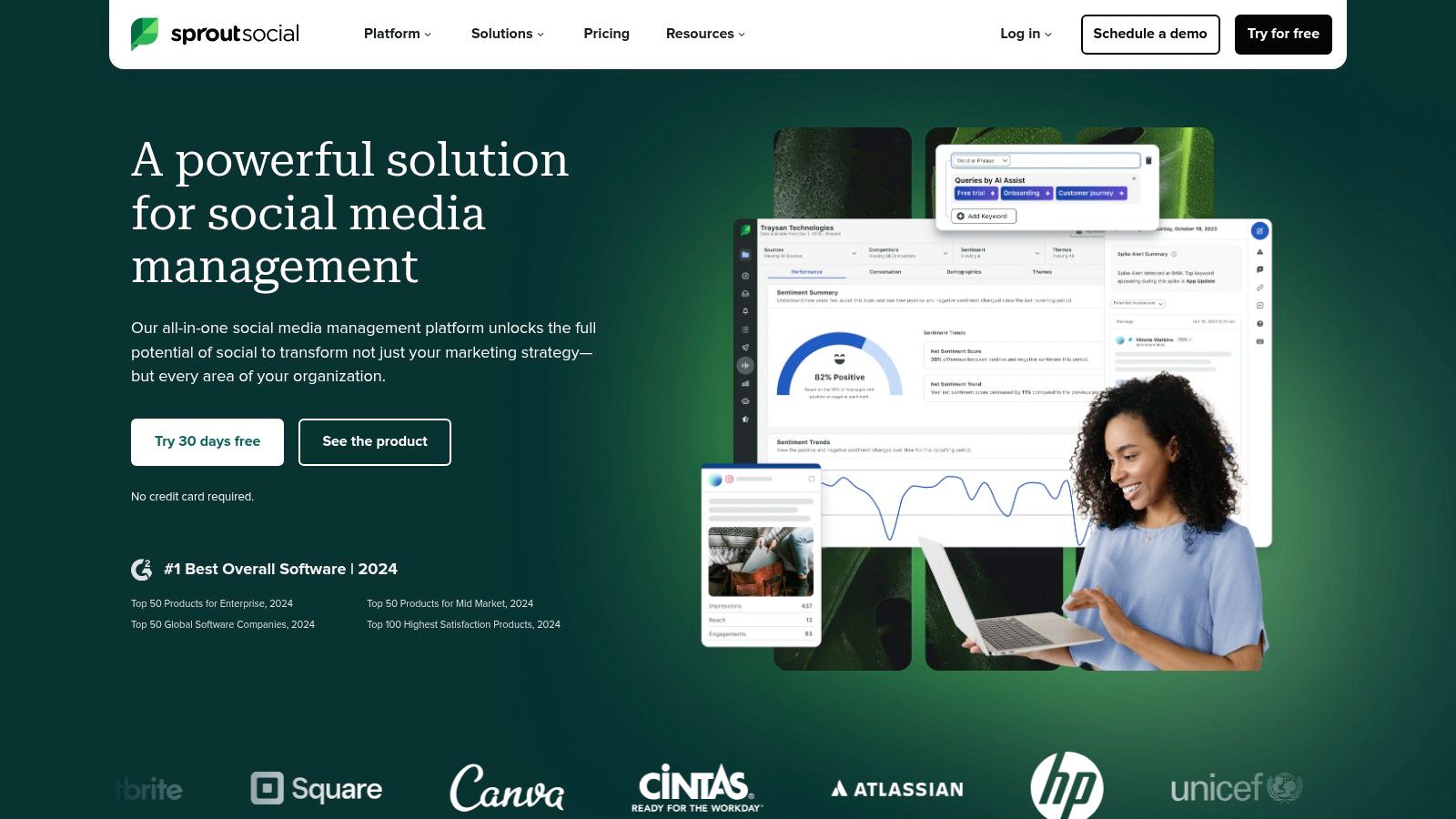
One of Sprout Social’s key strengths is its advanced feature set. The platform boasts a streamlined content approval and publishing workflow, allowing teams to collaborate efficiently and ensure all content aligns with brand guidelines. Integrated social listening tools enable you to monitor brand mentions, industry trends, and competitor activity, providing valuable insights for content creation and campaign optimization. The detailed analytics dashboard offers custom reporting options, allowing you to track key performance indicators (KPIs) and demonstrate the impact of your social media efforts. Furthermore, Sprout Social excels in multi-brand and multi-account management, simplifying the process of overseeing multiple social profiles from a centralized platform. It even leverages AI-powered content optimization suggestions to help refine your content strategy and improve engagement.
While Sprout Social’s robust capabilities make it an excellent choice for larger businesses and agencies, its higher price point might be a barrier for smaller businesses or individual users. Pricing varies based on the plan selected (Standard, Professional, Advanced), starting at $249 per month. Each tier unlocks additional features, such as advanced reporting, automation tools, and premium support. You can contact their sales team for a tailored quote. The platform can also be complex for new users, and there’s a learning curve involved in mastering all its functionalities. However, Sprout Social offers excellent customer support and comprehensive training resources to assist users in getting the most out of the platform. Technical requirements are minimal, as the platform is primarily web-based and accessible from any modern browser. Mobile apps are also available for iOS and Android devices, enabling users to manage their social media presence on the go.
Compared to simpler social media content planning templates like free Google Sheets templates or basic scheduling tools, Sprout Social offers a significantly more advanced and integrated experience. While free templates are great for basic scheduling and content organization, they lack the robust analytics, social listening, and team management capabilities of Sprout Social. Similarly, basic scheduling tools might offer automated posting but fall short in terms of in-depth reporting and strategic insights. If your needs extend beyond basic scheduling and you require a comprehensive solution for managing a complex social media presence, then Sprout Social’s robust feature set justifies the investment.
Implementing Sprout Social effectively involves a few key steps. First, clearly define your social media goals and KPIs. Then, integrate all your social media accounts into the platform and configure user roles and permissions for your team members. Take advantage of the platform’s social listening tools to understand your audience and identify relevant content themes. Utilize the content calendar template to plan and schedule your posts, and use the approval workflows to ensure consistent brand messaging. Finally, regularly review the analytics dashboard to track your performance and refine your strategy based on data-driven insights. By following these steps, you can harness the full potential of Sprout Social’s content calendar template and elevate your social media strategy. You can learn more and explore their offerings on their website: https://www.sproutsocial.com.
4. CoSchedule’s Marketing Calendar Template
CoSchedule’s Marketing Calendar template offers a robust solution for managing not just your social media content, but your entire marketing strategy. It moves beyond a simple social media content planning template to encompass a comprehensive view of all marketing activities, from blog posts and email campaigns to social media updates and advertising efforts. This unified approach is incredibly valuable for teams juggling multiple channels and campaigns, providing a centralized hub for planning, execution, and analysis. It earns its place on this list by offering a powerful, albeit more complex, alternative to basic social media calendars, perfect for those seeking a truly integrated marketing approach.
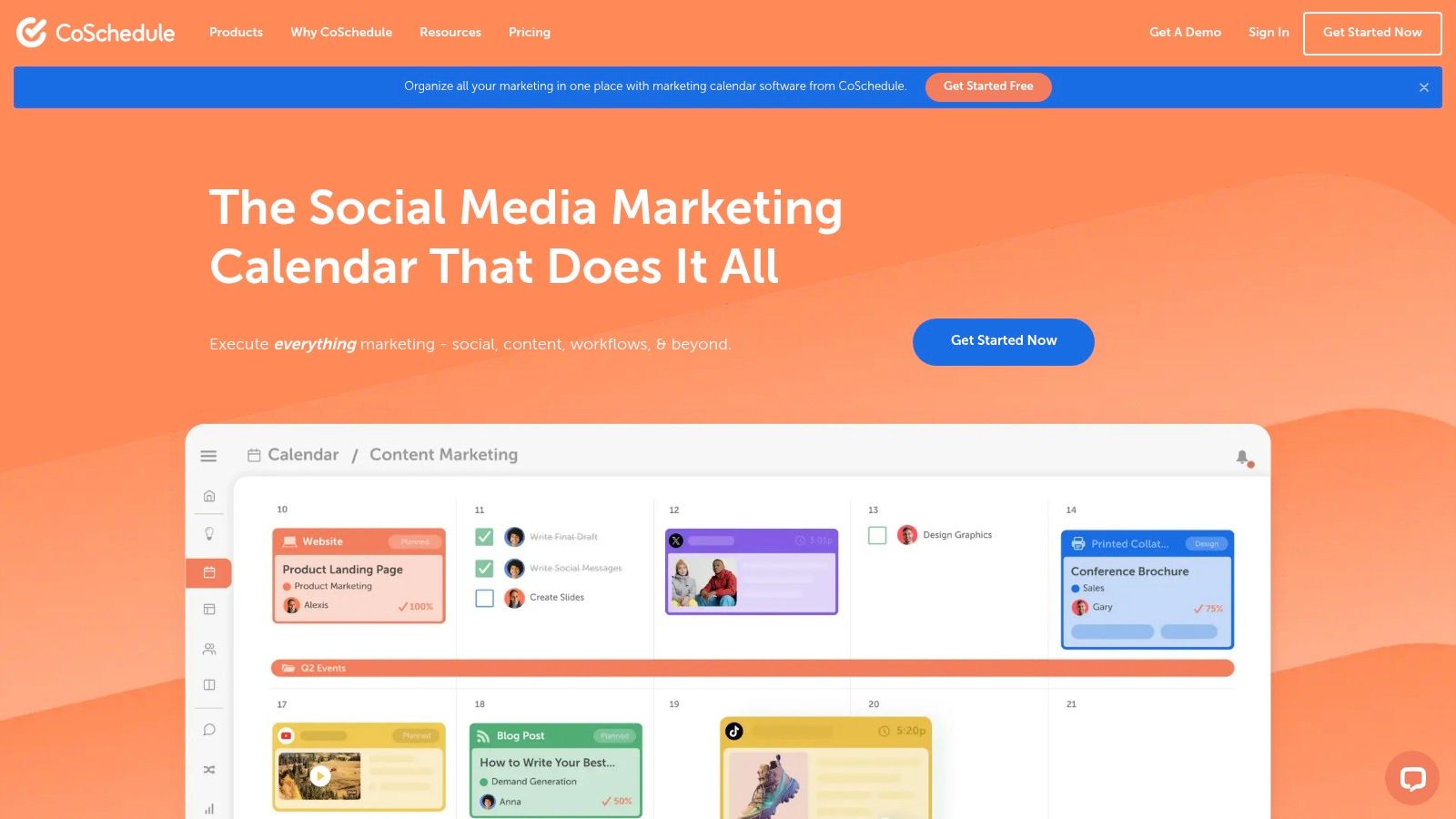
For instance, imagine you’re launching a new product. With CoSchedule, you can plan your social media campaign alongside your email marketing sequence, blog content schedule, and even advertising initiatives. This unified view ensures consistent messaging and optimal timing across all channels, maximizing the impact of your product launch. Instead of hopping between different tools and spreadsheets, everything resides within CoSchedule, streamlining your workflow and reducing the risk of missed deadlines or conflicting messaging. You can visualize how your social media content planning template integrates with the bigger picture, ensuring your social media efforts support your overall marketing goals.
CoSchedule provides advanced project management capabilities with task assignments, deadlines, and progress tracking. This is essential for teams, enabling efficient collaboration and accountability. Imagine assigning team members specific social media posts, setting due dates, and monitoring progress directly within the calendar. This eliminates the need for separate project management tools and keeps all communication centralized. This feature alone can significantly improve team efficiency and ensure that everyone is on the same page.
This platform also offers marketing campaign templates and automation workflows to streamline repetitive tasks. Pre-built templates for various marketing campaigns, including social media campaigns, can save you valuable time and effort in the planning process. Automation features can further enhance efficiency by automatically scheduling posts and triggering actions based on predefined rules. This frees up your time to focus on strategic planning and content creation rather than manual tasks.
Collaboration is another strength of CoSchedule, with real-time editing and commenting features. Team members can collaborate on content calendars, provide feedback, and make adjustments in real-time, fostering a more collaborative and efficient workflow. This seamless collaboration ensures that everyone is aligned and that content is reviewed and approved efficiently.
CoSchedule integrates seamlessly with a variety of popular marketing tools like WordPress, Mailchimp, and Google Analytics. This integration streamlines your workflow by connecting your social media content planning with other essential marketing platforms. For example, you can schedule social media posts directly from your WordPress dashboard or track the performance of your social media campaigns in Google Analytics.
While powerful, CoSchedule’s comprehensive feature set can be overwhelming for smaller teams focused solely on social media management. The extensive features and functionalities may require a higher learning curve compared to simpler social media scheduling tools. Learn more about CoSchedule’s Marketing Calendar Template and other similar tools to compare functionalities. The pricing structure, while offering value for larger teams and complex campaigns, might be a barrier for smaller businesses or individual content creators. Specific pricing details are available on their website, but it’s generally a higher investment than basic social media scheduling tools.
To effectively implement CoSchedule, start by clearly defining your marketing goals and identifying the key channels you’ll be using. Then, explore the available templates and customize them to fit your specific needs. Take advantage of the integration options to connect with your existing marketing tools. Finally, invest time in training your team to maximize the platform’s potential.
Despite its complexity and cost, CoSchedule’s Marketing Calendar template offers a powerful solution for teams seeking a truly unified marketing approach. Its ability to integrate social media content planning with broader marketing efforts provides invaluable insights and streamlines workflow, making it a worthy investment for those who need more than just a basic social media content planning template. You can visit their website https://www.coschedule.com for more detailed information.
5. Later’s Visual Content Calendar
Later’s Visual Content Calendar is a powerful social media content planning template specifically designed for visual platforms. If your social media strategy relies heavily on Instagram, Pinterest, TikTok, or other visually-driven platforms, Later offers a compelling solution for streamlining your content creation and scheduling process. This template makes it easier to curate a cohesive and engaging feed, ensuring your visuals align with your brand aesthetic and resonate with your target audience. It’s a valuable tool for anyone looking to elevate their visual storytelling and maximize their impact on these platforms, making it a worthy addition to any list of top social media content planning templates.
For teams managing multiple platforms, combining a visual planner with reliable Facebook content scheduling helps ensure posts are published consistently without manual work.
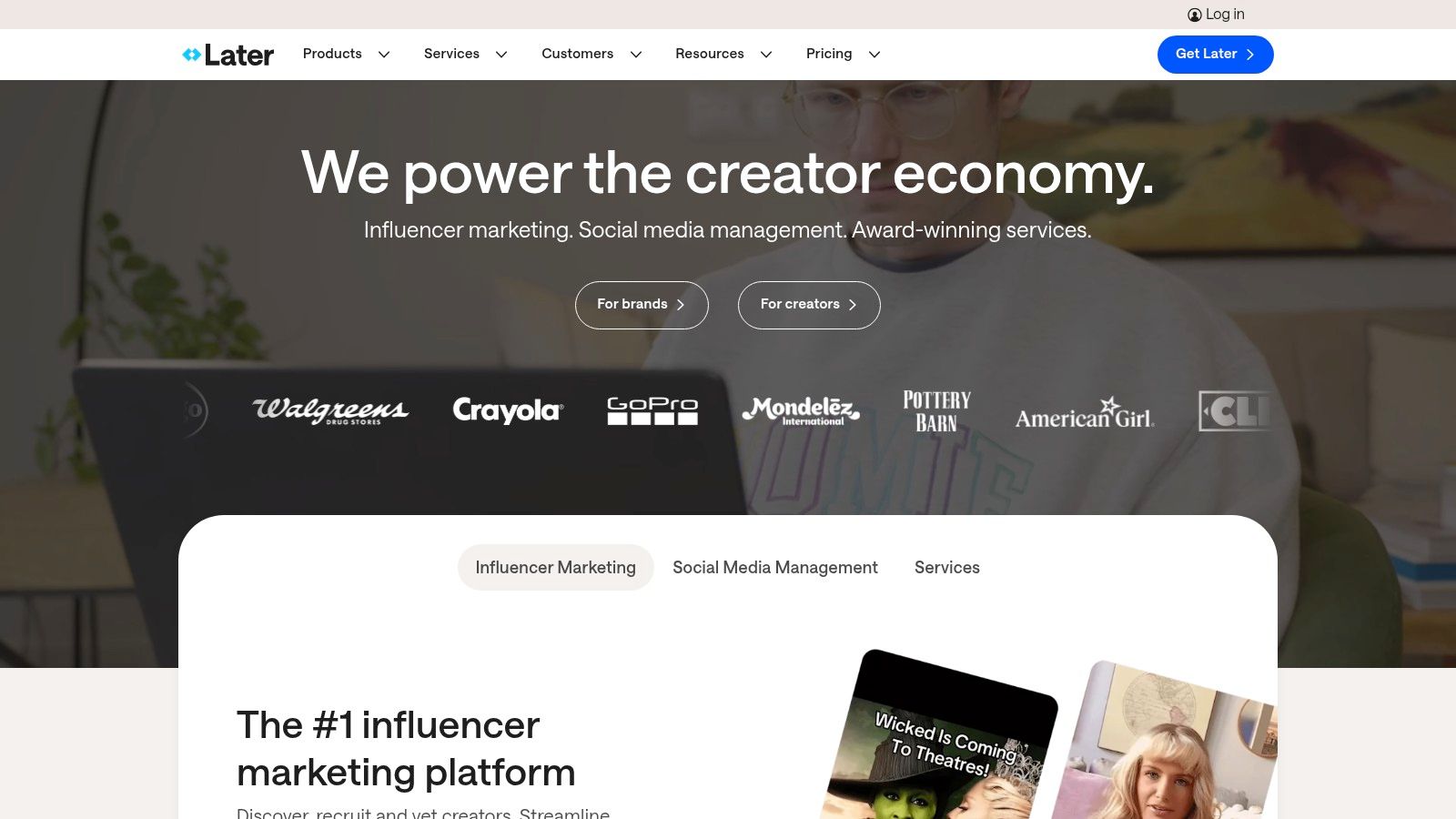
One of Later’s key strengths lies in its drag-and-drop interface. This functionality provides a clear visual preview of how your scheduled posts will appear in your feed before you publish them. This is invaluable for maintaining a consistent aesthetic and planning themed content blocks. Imagine easily rearranging posts to optimize for visual flow and ensuring your grid looks exactly how you envisioned. No more last-minute scrambling or unexpected disruptions to your carefully curated feed.
Beyond the visual planning aspect, Later boasts a suite of features tailored specifically for Instagram. You can plan and schedule Stories, Reels, and even IGTV content directly within the platform. This streamlines your workflow, allowing you to manage all your Instagram content in one centralized location. Hashtag research is also integrated, providing suggestions and insights to help you reach a wider audience. And, if you leverage user-generated content (UGC), Later simplifies the process of collecting, organizing, and scheduling this valuable content.
For busy social media managers and content creators, Later simplifies many time-consuming tasks. Instead of juggling multiple tools and platforms, you can plan, schedule, and analyze your visual content all within Later’s intuitive interface. This not only saves time but also allows for a more strategic and cohesive approach to social media marketing. For instance, a small business owner can easily plan a week’s worth of Instagram posts in one sitting, ensuring consistent messaging and a visually appealing feed, all while freeing up time to focus on other aspects of their business.
While Later excels in visual content planning, it does have some limitations. Its features for text-based platforms like Twitter and LinkedIn are less robust. If your social media strategy relies heavily on these platforms, you might find Later’s functionality lacking. Additionally, while Later offers analytics, they may not be as detailed as those provided by some full-featured social media management suites. Advanced users looking for granular data and in-depth reporting might need to supplement Later with other analytical tools.
Later offers various pricing plans, including a free option that provides essential features for individuals or small businesses just starting out. Paid plans unlock additional features and capabilities, such as increased post scheduling and more advanced analytics. Learn more about Later’s Visual Content Calendar and compare the different pricing tiers to find the best fit for your needs.
Setting up Later is straightforward. Simply connect your social media accounts, and you’re ready to start planning and scheduling your visual content. The intuitive interface makes it easy to navigate the platform and quickly get up to speed, even for users with limited technical experience.
In conclusion, Later’s Visual Content Calendar is a valuable tool for anyone focused on visual social media platforms. Its drag-and-drop interface, Instagram-specific features, and hashtag research tools make it a strong contender in the realm of social media content planning templates. While it may not be a perfect fit for everyone, particularly those heavily reliant on text-based platforms, its strengths in visual planning and Instagram management make it an excellent choice for many content creators, influencers, and businesses looking to elevate their visual storytelling on social media.
6. Trello’s Social Media Content Board Template
Trello, a popular project management platform, offers a robust and flexible social media content planning template that leverages its intuitive card-based system. This template provides a visual and organized way to manage your entire social media content workflow, from brainstorming ideas to scheduling posts and tracking performance. It’s a particularly attractive option for those seeking a free, customizable, and collaborative solution for their social media content planning needs. This template’s strength lies in its adaptability, allowing users to tailor it to various content strategies and team sizes, making it a valuable tool for anyone managing a social media presence.
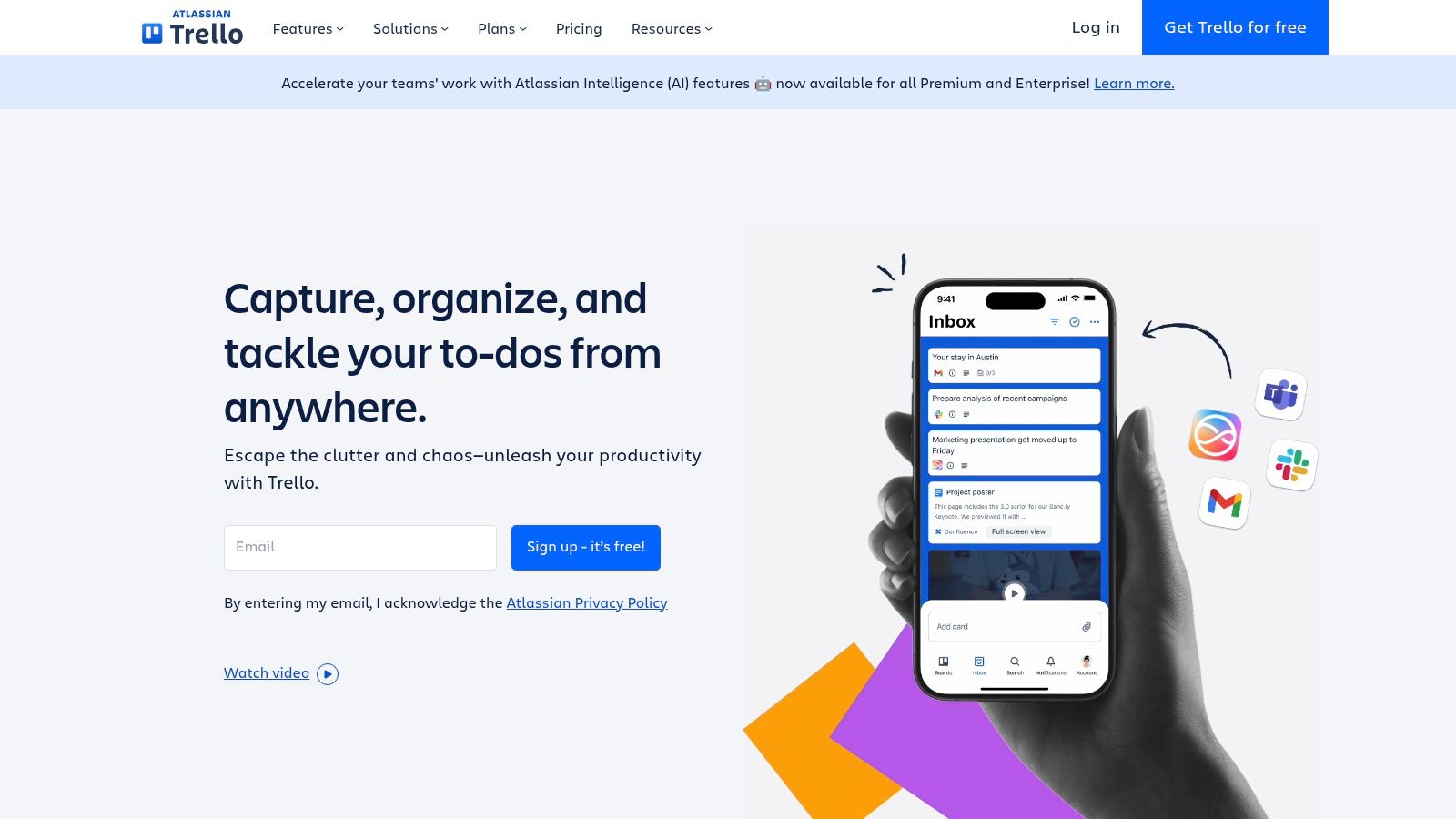
Trello’s social media content board template uses a Kanban-style board layout, with lists representing different stages of the content creation process. These lists could include “Ideas,” “In Progress,” “Scheduled,” and “Published,” though they are entirely customizable to your specific workflow. Within each list, individual cards represent specific content pieces. Each card can contain a wealth of information, including the content title, description, target platform, assigned team member, due date, and attached files like images or videos.
The template’s flexibility shines through its customizable labeling system. You can use labels to categorize content by type (blog post, video, infographic), platform (Instagram, Facebook, Twitter), or status (draft, in review, completed). This granular control allows for efficient filtering and sorting, making it easy to locate specific content pieces or track progress across different campaigns. For teams, Trello facilitates seamless collaboration through comments, file sharing, and @mentions. Team members can discuss ideas directly within cards, provide feedback, and stay updated on project progress.
Trello also integrates seamlessly with a variety of other tools through its “Power-Ups” feature. You can connect your Trello board to Google Drive, Dropbox, and calendar applications, centralizing all your relevant files and deadlines in one place. This interconnectivity streamlines workflows and reduces the need to switch between different platforms. While the Trello template doesn’t offer built-in social media scheduling, this gap can be bridged by integrating with scheduling tools through Power-Ups, effectively turning your Trello board into a comprehensive social media command center.
Pricing and Technical Requirements:
Trello offers a free version with generous features, making it accessible to individuals and small teams. Paid plans offer additional features like advanced checklists, custom fields, and larger file attachment limits, catering to the needs of larger teams and businesses. Trello is a web-based application and also offers mobile apps for iOS and Android, ensuring accessibility from virtually anywhere.
Comparison with Similar Tools:
Compared to dedicated social media management platforms like Hootsuite or Buffer, Trello lacks native scheduling and analytics capabilities. However, its strength lies in its flexibility and customization options, making it ideal for content planning and team collaboration. Tools like Asana offer similar project management functionalities but may not be as visually intuitive for managing social media content workflows.
Implementation and Setup Tips:
- Customize the lists: Adapt the default lists to match your specific content creation process.
- Utilize labels: Create a clear and consistent labeling system for content types, platforms, and status.
- Integrate Power-Ups: Connect with other tools like Google Drive and calendar apps to centralize your resources.
- Establish a consistent workflow: Define clear roles and responsibilities for each team member.
- Regularly review and update: Keep your board organized and up-to-date to ensure optimal efficiency.
Pros:
- Highly flexible and customizable workflows.
- Free version available with robust features.
- Familiar interface for teams already using Trello.
- Strong collaboration and file-sharing capabilities.
Cons:
- Lacks built-in social media scheduling and publishing (though integrations are possible).
- No native analytics or performance tracking.
- Requires manual setup and customization to match specific needs.
Website: https://trello.com
Trello’s social media content planning template earns its place on this list due to its adaptability, collaborative features, and free access to core functionalities. While it may not replace a dedicated social media management tool for scheduling and analytics, its strength lies in providing a centralized hub for organizing, planning, and collaborating on social media content, making it a valuable asset for individuals and teams of all sizes. It truly shines as a powerful social media content planning template.
7. Notion’s Social Media Content Planner Template
For content creators and businesses seeking a highly customizable and comprehensive solution, Notion’s social media content planner template stands out as a powerful tool. This template blends the flexibility of a database with the visual clarity of a calendar, offering a centralized hub for planning, organizing, and managing your social media presence. It’s particularly appealing to those who appreciate a deep level of control over their workflow and want a single workspace that can adapt to their evolving needs. This social media content planning template excels at providing a structured yet adaptable environment for managing your social media strategy.
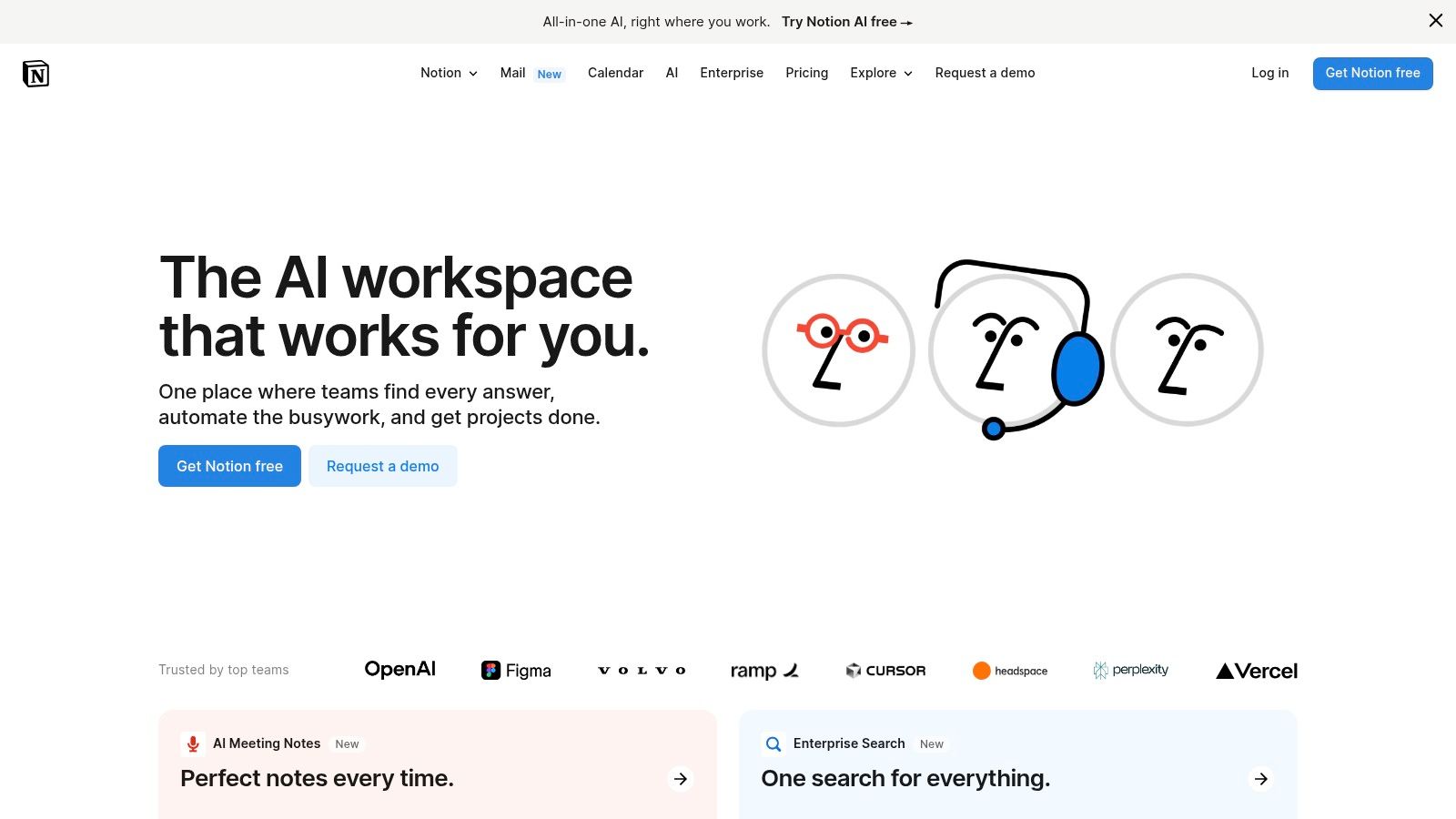
One of Notion’s greatest strengths is its database-driven approach to content organization. Within the social media content planner template, you can create detailed entries for each planned post, including custom properties like target audience, platform, content type, hashtags, and campaign goals. This granular level of detail allows for powerful filtering and sorting, making it easy to find specific content or analyze performance across different campaigns. For instance, you can filter your content calendar to view only Instagram posts scheduled for a specific product launch, or quickly identify top-performing content based on engagement metrics you’ve tracked. This level of organization is crucial for data-driven decision-making and optimizing your social media strategy over time.
The multiple view options within Notion further enhance the template’s usability. Toggle between a calendar view for a visual overview of your scheduled posts, a Kanban board for managing content through different stages (e.g., ideation, drafting, scheduling, published), or a table view for a detailed, spreadsheet-like analysis of your content. This flexibility allows you to tailor the view to your specific needs, whether you’re brainstorming new ideas, tracking progress, or reporting on campaign performance. Notion also offers a template and content snippet library, promoting consistency in your posting and streamlining the content creation process.
Notion’s integration capabilities are another major advantage. You can seamlessly link your social media content planner to other Notion pages and databases, creating a truly interconnected workspace. For example, you could link your content calendar to your marketing strategy document, project management board, or even your team’s content calendar. This interconnectedness reduces silos and ensures everyone is working from the same information.
Compared to standalone social media scheduling tools, Notion offers greater flexibility and customization but lacks built-in publishing and analytics features. While you can’t directly schedule posts from Notion, the template’s organization and detailed content entries can significantly streamline your workflow when using a separate scheduling tool. Think of Notion as your central content hub and a scheduling tool as the delivery mechanism. This combination provides the best of both worlds: detailed planning and efficient scheduling.
For new users, Notion can present a steep learning curve. Its flexibility can also be overwhelming if not managed effectively. Invest time in understanding Notion’s core concepts and experimenting with different organizational structures before diving into complex projects. The abundance of online resources, tutorials, and shared templates within the Notion community can significantly ease the learning process.
Notion offers a generous free tier suitable for individual users and small teams. Paid plans provide increased storage, collaboration features, and access to advanced functionalities, catering to larger teams and businesses. This affordable pricing model makes Notion accessible to a wide range of users.
Implementation Tips:
- Start Simple: Begin with a basic version of the template and gradually customize it as your needs evolve. Avoid adding too many custom properties at the beginning.
- Utilize Templates: Leverage pre-built templates and content snippets to ensure consistency and save time.
- Establish a Clear Workflow: Define roles and responsibilities for content creation, approval, and scheduling.
- Integrate with other tools: Connect your Notion workspace with your preferred social media scheduling and analytics platforms.
- Explore the Notion Community: Take advantage of the wealth of resources, tutorials, and shared templates available online.
Notion’s social media content planner template is a powerful tool for anyone seeking a flexible, customizable, and all-in-one workspace for social media management. While it requires some initial investment to learn and configure, the long-term benefits in terms of organization, efficiency, and collaboration can be significant. Visit https://www.notion.so to explore Notion and its powerful template library.
Top 7 Social Media Content Planning Templates Comparison
| Product | Core Features & Unique Selling Points ✨ | User Experience & Quality ★★★★☆ | Target Audience 👥 | Value & Pricing 💰 | Highlights 🏆 |
|---|---|---|---|---|---|
| Hootsuite’s Social Media Content Calendar | Multi-platform planning, campaign tracking, team approval workflows | Professional design, strong collaboration | Businesses & marketers | Free & premium plans 💰💰 | Seamless Hootsuite integration 🏆 |
| Buffer’s Content Planning Template | Drag-and-drop, content ideation, mobile-friendly | Clean, intuitive, beginner-friendly | Small to medium teams & beginners | Free tier available 💰 | Simple & effective for small teams 🏆 |
| Sprout Social’s Content Calendar Template | Advanced approval, social listening, AI content optimization | Enterprise-grade, comprehensive analytics | Enterprise & multi-brand teams | Premium pricing 💰💰💰 | Robust analytics & AI suggestions 🏆 |
| CoSchedule’s Marketing Calendar Template | Unified marketing calendar, task assignments, marketing automation | Extensive features, strong project management | Marketing teams across channels | Higher price 💰💰 | All-in-one marketing planning 🏆 |
| Later’s Visual Content Calendar | Visual drag-and-drop, IG Stories & Reels planning, hashtag tools | Intuitive visual interface, good free plan | Visual-first platforms, Instagram users | Free & paid plans 💰 | Best for Instagram & visual content 🏆 |
| Trello’s Social Media Content Board Template | Kanban layout, customizable cards, integrations | Highly flexible, familiar interface | Agencies, creative teams | Free tier robust 💰 | Custom workflows with strong collaboration |
| Notion’s Social Media Content Planner Template | Database-driven, multiple views, template library | Flexible but complex, all-in-one workspace | Creators & small businesses | Affordable, generous free tier 💰 | Customizable & integrated workspace 🏆 |
Ready to Plan Like a Pro?
From Hootsuite’s comprehensive calendar to Later’s visual focus and Trello’s collaborative boards, we’ve explored a range of social media content planning templates to suit diverse needs. The key takeaway is that a well-structured template, combined with the right tools, empowers you to create engaging content, maintain consistency, and ultimately, achieve your social media objectives. Remember to consider factors like your team size, budget, content formats, and desired level of automation when selecting the best fit for your workflow.
Choosing the right tool can significantly impact your content planning process. For visually-driven creators, Later might be ideal. If you prioritize team collaboration, Trello or CoSchedule could be a better choice. For those seeking an all-in-one platform, Hootsuite or Sprout Social are worth exploring. Notion can be a powerful tool for social media planning, and there are numerous resources available to help you maximize its potential. For a comprehensive guide on using Notion effectively, check out this resource: Notion How To.
Efficient content planning isn’t just about creating great content; it’s about strategically delivering it to your audience. A well-chosen social media content planning template provides the foundation for that success.
Ready to elevate your social media strategy with a powerful, open-source platform? Postiz offers AI-powered assistance, seamless collaboration tools, and flexible content scheduling features to complement your chosen template. Discover how Postiz can streamline your workflow and amplify your social media presence. Visit Postiz today and start planning like a pro!





